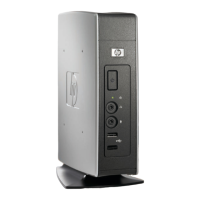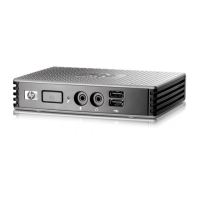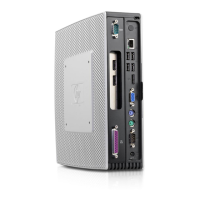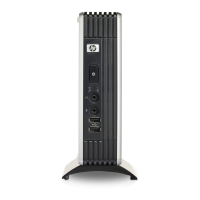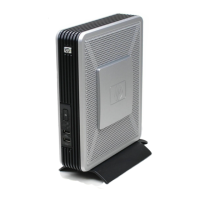Do you have a question about the HP t510 and is the answer not in the manual?
| Processor cores | 2 |
|---|---|
| Processor model | U4200 |
| Processor family | VIA Eden |
| Motherboard chipset | VIA VX900 |
| Processor frequency | 1 GHz |
| Storage media | Flash |
| Card reader integrated | No |
| Total storage capacity | 1 GB |
| Internal memory | 2 GB |
| Memory clock speed | 1066 MHz |
| Internal memory type | DDR3-SDRAM |
| Graphics card | Chromotion HD 2.0 |
| Networking features | Gigabit Ethernet |
| Graphics card family | VIA |
| Dimensions (W x D x H) with stand | 58.4 x 215.9 x 219.7 mm |
| Wi-Fi | Yes |
| Wi-Fi standards | 802.11a, 802.11b, 802.11g |
| Cabling technology | 10/100/1000Base-T(X) |
| USB 2.0 ports quantity | 6 |
| Ethernet LAN (RJ-45) ports | 1 |
| VGA (D-Sub) ports quantity | 0 |
| Operating system installed | - |
| Power supply | 65 W |
| AC input voltage | 100-240 V |
| AC input frequency | 50 - 60 Hz |
| Audio system | 24-bit |
| Sustainability certificates | ENERGY STAR |
| Product color | Black |
| Country of origin | China |
| Depth | 215.9 mm |
|---|---|
| Width | 58.4 mm |
| Height | 209 mm |
| Weight | 1490 g |
General overview of common features and capabilities of HP thin clients, including setup time and management.
Identifies and describes the components located on the front panel of the HP thin client.
Details the components found on the top exterior and interior of the HP thin client.
Explains the various connectors and slots present on the rear panel of the HP thin client.
Step-by-step guide for attaching the wireless antenna to the thin client.
Instructions for attaching rubber feet for stable horizontal placement of the thin client.
Procedure for attaching the stand to orient the thin client vertically.
Steps to detach the stand from the thin client.
Explains how to use the power cord retention slot to prevent accidental disconnection.
Details the keyboard layout and function of specific keys on the HP thin client.
Describes the functions of the Windows Logo Key when used in combination with other keys.
Lists and explains key combinations for additional functions on the thin client.
Explains how mouse button functions are determined by the software applications used.
Shows where to find the unique serial number on the thin client for support.
Outlines the essential steps and precautions for installing or replacing hardware components on the thin client.
Detailed procedure for removing and reinstalling the cover for the secure USB compartment.
Steps for removing and replacing the side access panel and the metal side cover.
Introduces various optional components that can be installed on the thin client.
Instructions for inserting a USB device into the secure USB compartment.
Detailed steps for removing and installing the internal battery of the thin client.
Guide for installing a secondary flash memory module onto the system board.
Information on available external USB drives and where to find more details.
Provides physical dimensions of the HP 1510 Thin Client in millimeters and inches.
States the approximate weight of the thin client in kilograms and pounds.
Specifies the operating and non-operating temperature ranges for the thin client.
Details the acceptable operating and non-operating humidity levels.
Lists the maximum operating and non-operating altitudes for the thin client.
Information on the voltage range, line frequency, and power output of the thin client's power supply.
Instructions on how to use a security cable lock to prevent unauthorized removal and secure the compartment.
Explains the HP Quick Release feature for mounting the thin client using VESA standards.
Illustrates various supported methods for mounting the thin client using the HP Quick Release.
Provides guidelines for the proper care and maintenance of the thin client.
Precautions to take to avoid damage from static electricity when handling components.
Various methods for grounding oneself to prevent electrostatic discharge.
Steps and suggestions for preparing the thin client for shipping.
Guidelines for returning the thin client for repair or exchange, including data safeguarding.


